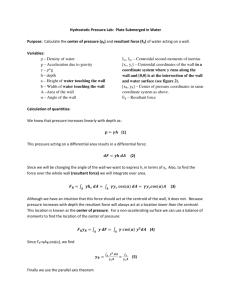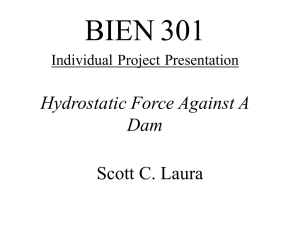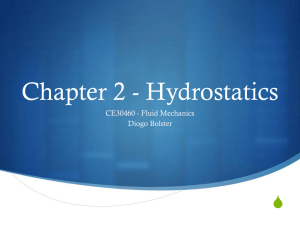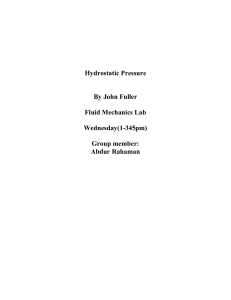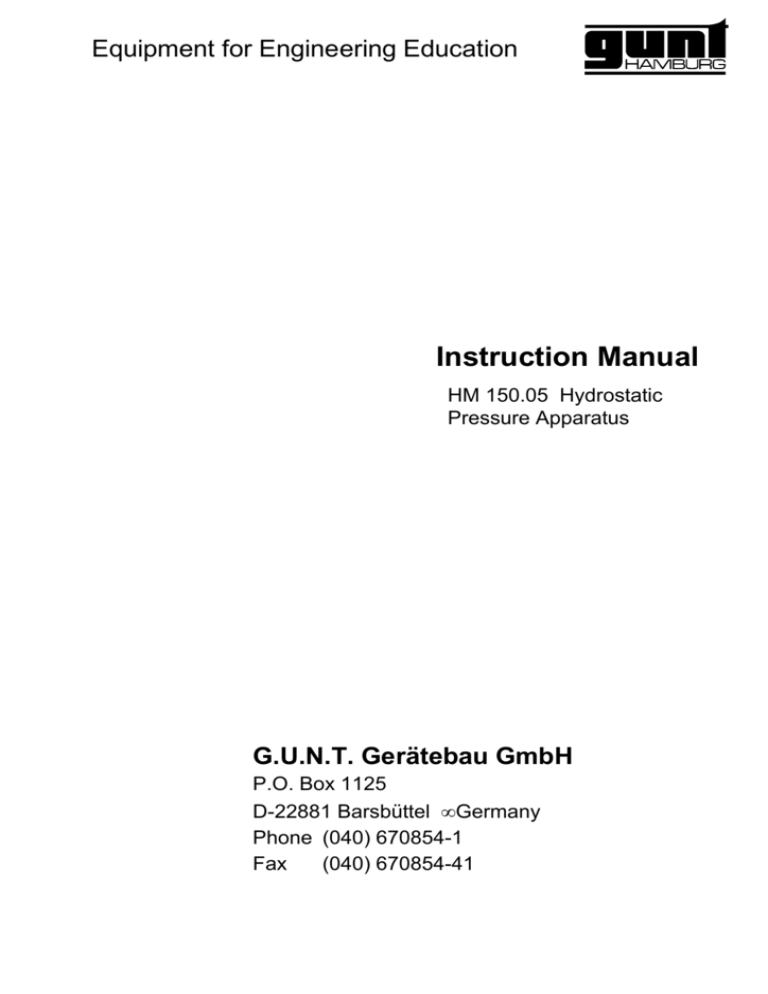
Equipment for Engineering Education
Instruction Manual
HM 150.05 Hydrostatic
Pressure Apparatus
G.U.N.T. Gerätebau GmbH
P.O. Box 1125
D-22881 Barsbüttel • Germany
Phone (040) 670854-1
Fax
(040) 670854-41
All rights reserved G.U.N.T. Gerätebau GmbH, Barsbüttel , Germany, 11/96
HM 150.05 Hydrostatic Pressure Apparatus
Instruction Manual
Publication no.:917.00005A15012
12/96
HM 150.05 Hydrostatic Pressure Apparatus
Table of Contents
1
Introduction. . . . . . . . . . . . . . . . . . . . . . . . . . . . . . . . . . . . . . . 1
2
Unit Description . . . . . . . . . . . . . . . . . . . . . . . . . . . . . . . . . . . 2
2.1
Commissioning . . . . . . . . . . . . . . . . . . . . . . . . . . . . . . . . . . . . . . . . . 3
2.2
Care and Maintenance. . . . . . . . . . . . . . . . . . . . . . . . . . . . . . . . . . . . 3
All rights reserved G.U.N.T. Gerätebau GmbH, Barsbüttel , Germany, 11/96
3
Theory on the Centre of Pressure . . . . . . . . . . . . . . . . . . . . . 4
3.1
Determining the Centre of Pressure . . . . . . . . . . . . . . . . . . . . . . . . . 5
3.2
Determining the "Resultant Force". . . . . . . . . . . . . . . . . . . . . . . . . . . 6
3.3
Mode of Functioning of the HM 150.05 Unit . . . . . . . . . . . . . . . . . . . 7
4
Experiments Relating to the Centre of Pressure . . . . . . . . . . 8
4.1
4.2
4.3
5
Centre of Pressure with Vertical Positioning of the Water Vessel . . . 8
4.1.1
Performing the Experiment . . . . . . . . . . . . . . . . . . . . . . . . . . 8
4.1.2
Evaluating the Experiment . . . . . . . . . . . . . . . . . . . . . . . . . . 8
Centre of Pressure with Water Vessel Tilted . . . . . . . . . . . . . . . . . . 10
4.2.1
Performing the Experiment . . . . . . . . . . . . . . . . . . . . . . . . . 10
4.2.2
Evaluating the Experiment . . . . . . . . . . . . . . . . . . . . . . . . . 11
Centre of Pressure with 90° Positioning of the Water Vessel . . . . . 13
Appendix . . . . . . . . . . . . . . . . . . . . . . . . . . . . . . . . . . . . . . . 14
5.1
Worksheet for Centre of Pressure (HM 150.05) . . . . . . . . . . . . . . . 14
5.2
Symbols and Units . . . . . . . . . . . . . . . . . . . . . . . . . . . . . . . . . . . . . 14
5.3
Technical Data . . . . . . . . . . . . . . . . . . . . . . . . . . . . . . . . . . . . . . . . 15
HM 150.05 Hydrostatic Pressure Apparatus
1
Introduction
The effect of hydrostatic pressure is of major significance in many areas of engineering, such as
shipbuilding, the construction of dykes, weirs and
locks, and in sanitary and building services engineering.
All rights reserved G.U.N.T. Gerätebau GmbH, Barsbüttel , Germany, 11/96
With the HM 150.05 Hydrostatic Pressure Apparatus the following key topics can be investigated
by experimentation:
•
Pressure distribution in a liquid taking into account gravity
•
"Lateral force" of the hydrostatic pressure
•
Centre of pressure of the lateral force
T he appendix to this Test Instruction contains prepared worksheets which facilitate methodical evaluation of the results of the experiments.
The apparatus is designed for use in the fields of
education.
1 Introduction
1
HM 150.05 Hydrostatic Pressure Apparatus
2
Unit Description
All rights reserved G.U.N.T. Gerätebau GmbH, Barsbüttel , Germany, 11/96
6
3
4
2
5
1
7
8
1. Water vessel
2. Detent
3. Slider
4. Stop pin
2 Unit Description
5. Water level scale
6. Rider
7. Weights
8. Handles
2
HM 150.05 Hydrostatic Pressure Apparatus
With HM 150.05 "Hydrostatic Pressure Apparatus "the correlation between the water level and
the dependent side pressure can be investigated.
The unit is of robust construction and can be set
up quickly. It is therefore highly suitable for everyday use in schools and universities.
All rights reserved G.U.N.T. Gerätebau GmbH, Barsbüttel , Germany, 11/96
The unit can be easily transported by means of two
handles.
A transparent measuring vessel with mm scale
and a scale with mm increments permits precise
water level and lever arm readings.
2.1
Commissioning
The "Hydrostatic Pressure Apparatus" should
be placed on a horizontal, waterproof surface . An
additional vessel for filling and emptying the water
vessel should be provided.
2.2
Care and Maintenance
The unit and its accessories require practically no
maintenance. To prevent liming, empty the unit
after use and dry it with a soft cloth.
2 Unit Description
3
HM 150.05 Hydrostatic Pressure Apparatus
3
Theory on the Centre of Pressure
The hydrostatic pressure of liquids is the "gravitational pressure" phyd. It rises due to the intrinsic
weight as the depth t increases, and is calculated
from:
phyd = ρ⋅g⋅t.
(1)
All rights reserved G.U.N.T. Gerätebau GmbH, Barsbüttel , Germany, 11/96
ρ - Density of water
g - Acceleration due to gravity (g=9,81 m/s2)
t - Distance from liquid surface
To calculate forces acting on masonry dams or
ships’ hulls, for example, from the hydrostatic pressure, two steps are required:
•
Reduce the pressure load on an active surface
down to a resultant force Fp, which is applied
at a point of application of force, the "centre of
pressure", vertical to the active surface.
•
Determine the position of this centre of pressure by determining a planar centre of force on
the active surface.
It is first demonstrated how the centre of pressure
can be determined. The resultant force Fp is then
calculated.
3 Theory on the Centre of Pressure
4
HM 150.05 Hydrostatic Pressure Apparatus
3.1
Determining the Centre of Pressure
A linear pressure profile is acting on the active surface shown, because the hydrostatic pressure rises
proportional to the depth t.
α
t1
p1
yc
h
All rights reserved G.U.N.T. Gerätebau GmbH, Barsbüttel , Germany, 11/96
C
D
e
t2
Fp
A
p2
The resultant force Fp is therefore not applied at
the centre of force C of the active surface, but
always slightly below it, at the so-called centre of
pressure D! To determine the distance e of the
centre of pressure from the planar centre of force,
the following model demonstration is used:
Imagine an area A in front of the active surface,
formed by the height h and the pressure profile of
the hydrostatic pressure p1-p2. This area is in the
form of a trapezium.
Active surface
The centre of pressure D lies on the extension
of the planarcentre of force of this area A. A can
be broken down into partial areas A1 and A2. The
respective planar centres of force are identified by
black dots.
O1
p1
h
A1 2 2h h
3
yc
e
Fp
A balance of moments between the areas is
then established around the point O1 in order to
find the common planar centre of force (dynamic
effect in direction Fp):
α
A2
p2
Planar
center of
gravity
h
h
2h
ΣM(O1)=0: A⋅( +e) = A1⋅ +A2⋅
2
2
3
(2)
Where
A1 = p1⋅h,
A2 =
p2−p1
⋅h and
2
A = A1+A2
(3)
(4)
(5)
the result is
3 Theory on the Centre of Pressure
5
HM 150.05 Hydrostatic Pressure Apparatus
1 p −p
e = h⋅ 2 1 .
6 p2+p1
(6)
All rights reserved G.U.N.T. Gerätebau GmbH, Barsbüttel , Germany, 11/96
With the hydrostatic pressure
h
p2 = ρgcosα⋅(yc+ ) and
2
(7)
h
p1 = ρgcosα⋅(yc− ) the result is
2
(8)
e=
1 h2
⋅ .
12 yc
(9)
e is the distance of the centre of pressure from the
planar centre of force of the active surface which
we are looking for.
3.2
Determining the Resultant Force
α
h
2
yc
C
D
The hydrostatic pressure acting on the active surface can be represented as resultant force Fp, of
which the line of application leads through the
centre of pressure D. The size of this resultant force
corresponds to the hydrostatic pressure at the planar
centre of force C of the active surface:
t1
pc = ρ⋅g⋅tc
tc
t2
Fp
Active surface Aactiv
(10)
pc - Hydrostatic pressure at the planar centre
of force of the active surface
tc - Vertical distance of the planar centre of
force from the surface of the liquid
In visual terms, the pressure at the planar centre
of force corresponds to precisely the mean value
between the highest and lowest pressure, becau-
3 Theory on the Centre of Pressure
6
HM 150.05 Hydrostatic Pressure Apparatus
se of the linear pressure distribution.
If the wall is tilted by an angle α:
pc = ρ⋅g⋅cos α⋅yc.
(11)
The resultant force Fp can now be calculated:
All rights reserved G.U.N.T. Gerätebau GmbH, Barsbüttel , Germany, 11/96
Fp = pc⋅Aactive
(12)
Important! To calculate the resultant force the planar
centre of force of the active surface is applied, but the
line of application of the resultant force Fp runs through
the centre of pressure (see section 3.1).
3.3
Mode of Functioning of the HM 150.05 unit
O
r
yp
D
Gt
Gr
Fp
G
The unit’s water vessel is designed as a ring
segment with constant cross-section. The force
due to weight G of the water always produces the
same moment of momentum referred to the centre
of motion O as the resultant force Fp of the active
surface running through the centre of pressure D.
Consequently, this apparatus can be used to determine the force of pressure Fp and the centre of
pressure.
To illustrate the point, imagine the ring segment
completely filled. The force due to weight G applied
to the centre of volume of the water can be broken
down into two components:
•
A radially applied component Gr running precisely through the centre of motion, and
•
a tangential component Gt with a lever arm r
acting on the centre of motion O.
The radial component Gr exerts no momentum on
centre of motion O, because its lever arm is zero.
Now, regardless of the water level:
3 Theory on the Centre of Pressure
7
HM 150.05 Hydrostatic Pressure Apparatus
Fp⋅yp = Gt⋅r
(13)
That is to say, the force due to weight G of the
water volume always exerts the same moment
of momentum as the force Fp at the centre of
pressure D.
All rights reserved G.U.N.T. Gerätebau GmbH, Barsbüttel , Germany, 11/96
The derivation of (13) leads via determination of
the centre of force of a ring segment and its volume.
3 Theory on the Centre of Pressure
8
HM 150.05 Hydrostatic Pressure Apparatus
4
Experiments Relating to the Centre of Pressure
4.1
Centre of Pressure with Vertical Positioning of the Water Vessel
4.1.1
Performing the Experiment
4.1.1.1
Counterbalancing the Water Vessel
3
4
2
1
4.1.1.2
•
Counterbalance the unit with a rotating slider
(3): The stop pin (4) must be precisely in the
middle of the hole for this
Performing the Measurement
l
•
Mount the rider (6), set the lever arm on the
scale (e.g. l=150 mm)
•
Top up with water until the unit is balanced
(stop pin (4) at centre of hole)
•
Read off water level s and enter it in the
prepared worksheet (see Appendix)
•
Increase the appended weights (7) in increments of 0.5 - 1 N and repeat the measurement
4
°
90°
6
Set the water vessel (1) to an angle of α =0°
using the detent (2) as shown
60
All rights reserved G.U.N.T. Gerätebau GmbH, Barsbüttel , Germany, 11/96
α
•
0°
30
°
s
7
4.1.2
Evaluating the experiment
Measured values:
s - Water level reading
l - Lever arm of the force due to weight
FG - Force due to weight of the appended weights
4 Experiments Relating to the Centre of Pressure
9
HM 150.05 Hydrostatic Pressure Apparatus
4.1.2.1
Determining the Centre of Pressure
All rights reserved G.U.N.T. Gerätebau GmbH, Barsbüttel , Germany, 11/96
At a water level s, below the 100 mm mark, the height
of the active surface changes with the water level. If
the water level is above that mark, the height of the
active surface is always 100 mm.
Meaning:
s - Water level
e - Distance of centre of pressure D from planar
centre of force C of the active surface
lD - Distance to centre of motion of the unit:
lD
C
D
Triangular profile
s
e
For a water level s < 100 mm:
(pressure has a triangular profile)
Active surface
(1)
1
lD = 200mm − ⋅s
3
(2)
For a water level s > 100 mm:
(pressure has a trapezoidal profile)
lD
C
e=
s
1 (100mm)2
⋅
12 s−50mm
(3)
50mm
D
lD = 150mm + e
Trapezoidal profile Active surface
4.1.2.2
1
e = ⋅s
6
(4)
Determining the Resultant Force
The resultant force corresponds to the hydrostatic
pressure at the planar centre of force C of the
active surface. Thus, the height of water level s
must again be differentiated:
Meaning:
Aact - Superficial content of active surface
b=75 mm - Width of liquid vessel
pc - Hydrostat. pressure at planar centre of force
4 Experiments Relating to the Centre of Pressure
10
HM 150.05 Hydrostatic Pressure Apparatus
Fp - Resultant force for hydrostat. pressure
on active surface:
For s < 100 mm:
(triangular profile)
s
pc = ρ⋅g⋅ and Aact = s⋅b
2
s
100
mm
For s>100 mm:
(trapezoidal profile)
50
mm
pc = ρ⋅g⋅(s−50mm) and Aact = 100mm⋅b(6)
Aact
The resultant force is produced as
Fp = pc⋅Aact .
4.1.2.3
l
Calculated variables:
FG - Appended weight
l - Lever arm of appended weight referred to centre of motion O
O
lD
To check the theory, a balance of moments around
the centre of motion O can be established and
checked:
Fp
FG
(7)
Balance of Moments
ΣM(O)=0: FG⋅l = Fp⋅lD
4.2
Centre of Pressure with Water Vessel Tilted
4.2.1
Performing the Experiment
0°
30
Set an angle α and counterbalance the water
vessel as described under 4.1.1.1.
•
Enter the characteristic values in the prepared
worksheet: Lowest water level st and highest
water level sh of the active surface
•
Perform the measurement as described under
4.1.1.2.
°
sh
st
α
(8)
•
90°
60
°
All rights reserved G.U.N.T. Gerätebau GmbH, Barsbüttel , Germany, 11/96
Fp
C
D
(5)
Active area
4 Experiments Relating to the Centre of Pressure
11
HM 150.05 Hydrostatic Pressure Apparatus
4.2.2
Evaluating the experiment
The difference between evaluation of the tilted
vessel and that of the vertical vessel lies in the
translation of the water levels onto the tilted active
surface: A factor cosα must be taken into account
here.
All rights reserved G.U.N.T. Gerätebau GmbH, Barsbüttel , Germany, 11/96
4.2.2.1
Determining the centre of pressure
When the water vessel is at a tilt, too, a triangular
pressure profile is produced when the water level is
below sh; above that level a trapezoidal profile is
produced.
Measured values:
s - Water level reading
α - Tilt angle of vessel
α
ld
sh
s
e
st
h
Meaning:
st - Water level at lowest point of vessel
sh - Water level of active surface at rim
e - Position of centre of pressure
h - Height of active surface
lD - Distance between centre of pressure/centre
of motion
For a water level s < sh a triangular profile as follows
applies:
h=
s−st
cosα
(9)
1
e = ⋅h
6
(10)
1
lD = 200mm − ⋅h
3
(11)
For a water level s > sh a trapezoidal profile as
follows applies:
4 Experiments Relating to the Centre of Pressure
12
HM 150.05 Hydrostatic Pressure Apparatus
e=
1 (100mm)2
⋅
12 s−st
−50mm
cosα
lD = 150mm + e
All rights reserved G.U.N.T. Gerätebau GmbH, Barsbüttel , Germany, 11/96
4.2.2.2
(13)
Determining the resultant force
s
α
sh
Meaning:
Aact - Superficial content of active surface
b=75 mm - Width of liquid vessel
pc - Hydrostat. pressure at planar centre of force
of active surface
For s<sh with h from section 4.2.2.1:
pc = ρ⋅g⋅
Fp
(12)
s−st
and Aact = h⋅b
2
(14)
st
Aact
50mm⋅cosα
For s>sh the trapezoidal profile as follows applies:
pc = ρ⋅g⋅(s−st − 50mm⋅cosα) ,
(15)
Aact = 100mm⋅b
(16)
The resultant force is produced as
Fp = pc⋅Aact .
4.2.2.3
(17)
Balance of moments
The results can be checked with the balance of moments,
as described in section 4.1.2.3.
4 Experiments Relating to the Centre of Pressure
13
HM 150.05 Hydrostatic Pressure Apparatus
4.3
Centre of pressure with 90° positioning of the water vessel
The angle α=90° represents a special case. The
resultant pressure profile has the form of a triangle,
because the hydrostatic pressure is equal at every
point on the active surface.
C=D
s
st
For this reason, the centre of pressure C lies precisely at the planar centre of force D of the active
surface
All rights reserved G.U.N.T. Gerätebau GmbH, Barsbüttel , Germany, 11/96
lD
e=0
Fp
(18)
and has the lever arm
lD = 150mm.
(19)
The resultant force is produced as
Fp = ρ⋅g⋅(s−st)⋅(100mm⋅b)
(20)
The result can be checked with the balance of
moments from section 4.1.2.3.
4 Experiments Relating to the Centre of Pressure
14
HM 150.05 Hydrostatic Pressure Apparatus
5
Appendix
5.1
Worksheet for Centre of Pressure
Angle α [°]
All rights reserved G.U.N.T. Gerätebau GmbH, Barsbüttel , Germany, 11/96
Lever arm
l [mm]
Appended weight
FG [N]
Angle α [°]
Lever arm l [mm]
Appended weight
FG [N]
Angle α [°]
Lever arm l [mm]
5 Appendix
Appended weight
FG [N]
Lowest water level st
[mmWC]
Water level
reading s [mm]
Lowest water level st
[mmHOW]
Water level
reading s [mm]
Lowest water level st
[mmWC]
Water level
reading s [mm]
Highest water level sh
[mmWC]
Calculated lever
arm lD [mm]
Resultant force
Fp [N]
Highest water level sh
[mmHOW]
Calculated lever
arm lD [mm]
Resultant force Fp
[N]
Highest water level sh
[mmWC]
Calculated lever
arm lD [mm]
Resultant force Fp
[N]
15
HM 150.05 Hydrostatic Pressure Apparatus
5.2
Symbols and Units
ρ
Density of liquids
phyd Hydrostatic pressure
mmHOW
pc
Hydrostatic pressure in planar centre
of gravity of active surface
mmHOW
Fp
Resultant force in centre of pressure N
FG
Force due to weight of appended
weights
N
Force due to weight of water in
measuring vessel
N
h
Height of active surface
mm
b
Width of liquid container
mm
s
Water level reading/scale
mm
sh
Water level at highest point
of active surface
mm
Water level at lowest point
of measuring vessel
mm
G
All rights reserved G.U.N.T. Gerätebau GmbH, Barsbüttel , Germany, 11/96
g/cm3
st
e
Distance between centre of pressure
and planar centre of gravity
mm
lD
Lever arm of resultant force Fp
mm
l
Lever arm of force due to weight
mm
yp
Distance between centre of pressure and
liquid level along the active surface mm
yc
Distance between planar centre of
gravity and liquid level along the
active surface
mm
Aact Superficial content of active surface mm2
5.3
Technical data
Dimensions: LxWxH
400x500x360 mm3
Capacity of measuring vessel:
approx. 1.8 l
Weight:
approx. 10 kg
5 Appendix
16

